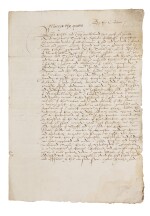English Literature, History, Children’s Books and Illustrations
English Literature, History, Children’s Books and Illustrations

Property of the Marquess of Anglesey
Queen Mary I., letter signed, 28 January 1554
Lot Closed
July 9, 01:03 PM GMT
Estimate
15,000 - 20,000 GBP
Lot Details
Description
Property of the Marquess of Anglesey
QUEEN MARY I
Letter signed, at the head (“Marye the quene”), to Lord Paget,
A CALL TO ARMS AT THE OUTBREAK OF WYATT’S REBELLION, warning that the Duke of Suffolk, together with others including “wyat of Kent”, have conspired “to stirre our subjectes in Kent and elleswhere to rebell again us, pretending upon false rumours spredd that the Prince of Spayne and the Spaniardes shulde come in to conquer this realme”, and “trayterously propose tadvaunce the Ladie Jane [Suffolk’s] daughter and Guildeforde Dudley her husband […] unto our Crowne and dignitie royall”, alerting Paget that Suffolk and his brothers have fled to Leicestershire and so ordering him “to Leavie all the power and force of horsemen and footemen that yow can” against these rebels in the Midlands, and place himself under the command of the Earl of Huntingdon, 2 pages, folio, integral address leaf, papered seal, St James’s Palace, 28 January 1554, light waterstaining
“…you shall ministre unto god and us and do your cuntrie great service according to your bounden naturall dutie...”
Wyatt’s Rebellion of January-February 1554 briefly threatened the Tudor crown, as a large rebel force of 4,000 men marched on London. The rebels intended to prevent Queen’s Mary’s marriage to Phiip of Spain, which they believed would result in England’s subordination to Spanish interests and strengthen the restored Catholic settlement; their leaders included Henry Grey, Duke of Suffolk – the father of Lady Jane Grey, the “nine-day queen” then imprisoned in the Tower – as well as the Kentish landowner Thomas Wyatt the Younger (son of the poet). In the event it was only Wyatt who was able to raise significant numbers to his banner. Paget and Huntingdon (who had himself been a supporter of Jane Grey and imprisoned in the Tower) soon brought the hapless Suffolk back to London, where he was executed on 23 February.
Please see shipping calculator link: click here.
